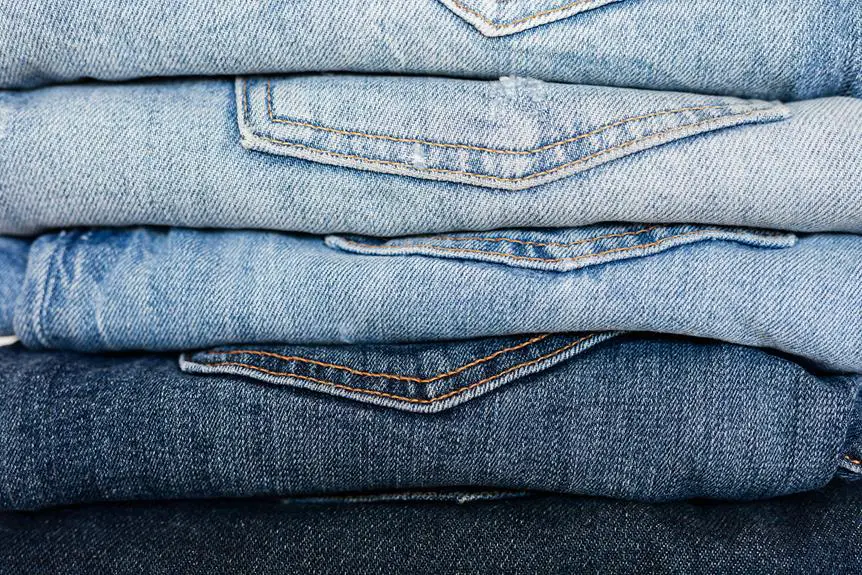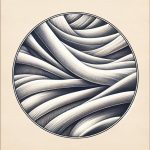When you're choosing between pinpoint and poplin, it's essential to understand how each fabric's unique characteristics can impact your wardrobe. Pinpoint's cotton-polyester blend gives it a structured and luxurious feel perfect for formal occasions, while poplin's 100% cotton composition offers lightweight breathability ideal for casual outings. Each fabric has its strengths and weaknesses, influencing everything from comfort to care. So, which one will ultimately suit your needs better? Let's explore the nuances that set these two fabrics apart.
Table of Contents
Fabric Composition
When comparing pinpoint and poplin, you'll notice that their fabric compositions play a crucial role in their texture and durability.
Pinpoint fabric is typically made from a blend of cotton and polyester, which gives it a soft feel while enhancing its resistance to wrinkles and fading. This blend makes pinpoint shirts ideal for both casual and formal settings, as they maintain a polished appearance throughout the day.
On the other hand, poplin is usually crafted from 100% cotton, offering a crisp, smooth finish. This pure cotton composition provides breathability, making poplin shirts comfortable to wear in warmer weather. However, poplin's lack of synthetic fibers means it may wrinkle more easily compared to pinpoint.
In terms of weight, pinpoint is generally thicker and can provide a more structured silhouette, while poplin is lighter, contributing to a more relaxed fit.
You'll find that each fabric has its unique advantages depending on your needs. If you're looking for versatility and durability, pinpoint might be your go-to. But if comfort and breathability are your priorities, poplin could be the better choice for you.
Weave Structure
When you consider weave structure, you'll notice how different techniques shape the fabric's texture and feel.
Pinpoint and poplin each offer unique characteristics that influence their durability and overall appearance.
Let's explore these differences to help you make an informed choice.
Weave Techniques Explained
Understanding the weave structure is essential for distinguishing between fabrics like pinpoint and poplin. The way a fabric is woven affects its durability, appearance, and suitability for different uses. Pinpoint features a finer yarn and a tighter weave, while poplin combines a simple, smooth surface with a slightly heavier weight.
Here's a quick comparison to help you grasp the differences:
| Feature | Pinpoint |
|---|---|
| Yarn Type | Finer, smoother yarn |
| Weave Technique | Tighter weave |
| Appearance | Crisp, formal look |
| Durability | High, resists wrinkles |
| Ideal Use | Dress shirts, formal wear |
Texture and Feel
How does the texture and feel of pinpoint and poplin fabrics influence your choice for different occasions?
When you touch pinpoint fabric, you'll notice its slightly raised texture, which gives it a refined and luxurious feel. This makes it ideal for formal events like business meetings or weddings, where you want to make a polished impression. The finer threads and tighter weave of pinpoint add a hint of sophistication, making it a go-to choice for dress shirts and tailored garments.
On the other hand, poplin has a smoother, crisp texture that feels lightweight against your skin. Its flat, even weave provides a breathable and comfortable experience, perfect for casual outings or warm weather. When you wear poplin, you're opting for a practical yet stylish option that can transition from day to night with ease.
Ultimately, your choice between pinpoint and poplin depends on the occasion and the look you want to achieve. If you're dressing up, pinpoint serves you well; if you're going for casual comfort, poplin is your best bet.
Consider the texture and feel carefully to elevate your wardrobe choices.
Durability Comparison
The differences in weave structure between pinpoint and poplin significantly affect their durability and how they hold up over time.
Pinpoint fabric features a tighter weave, combining fine yarns that create a sturdy yet lightweight material. This structure leads to increased resistance to wear and tear, making pinpoint shirts less prone to fraying or fading. If you're looking for something that can withstand frequent use while keeping a polished appearance, pinpoint is a strong choice.
On the other hand, poplin has a simpler, plain weave that, while soft and breathable, can be less durable over time. The larger gaps between the threads can make poplin more susceptible to wrinkles and damage, especially if it's subjected to regular washing and ironing.
If you don't mind a bit of wear and tear, poplin might still suit your needs, but you may find it requires more maintenance to keep it looking fresh.
Texture and Feel
When you touch pinpoint fabric, you'll notice a distinct texture that sets it apart from the smoother feel of poplin. Pinpoint has a slightly raised texture, giving it a more tactile quality that can enhance your overall wearing experience.
In contrast, poplin feels sleek and soft against the skin, making it a go-to choice for those who prefer a more refined touch.
Here are some key differences in texture and feel between the two fabrics:
- Pinpoint's Texture: The raised threads create a unique tactile experience, adding a bit of depth to your outfit.
- Poplin's Smoothness: The flat surface provides a clean, crisp appearance, ideal for formal settings.
- Breathability: Pinpoint's texture can allow for better airflow, which might make it feel cooler in warm weather.
- Drape: Poplin has a more structured drape, while pinpoint can offer a softer, more relaxed fall.
Ultimately, your choice between pinpoint and poplin will depend on your personal preference for texture and the specific look you want to achieve.
Each fabric has its own charm, so consider what feels best for you.
Durability and Wear
Pinpoint fabric typically offers greater durability compared to poplin, making it a better choice for long-lasting wear. When you invest in garments made from pinpoint, you're choosing a material that can withstand everyday use without showing signs of wear and tear as quickly as poplin. This increased durability stems from the tighter weave and heavier weight of pinpoint fabric, which helps it resist fraying and fading over time.
If you're someone who values longevity in your wardrobe, pinpoint is likely the better option. You won't have to worry about frequent replacements, saving you both time and money in the long run. Additionally, pinpoint's robust nature means it holds up well against spills and stains, making it a practical choice for various occasions.
On the other hand, while poplin is lighter and more breathable, it can wear out faster, especially with regular washing and use. If you're looking for a fabric that combines style and resilience, pinpoint is worth considering.
Ultimately, your choice between these two will depend on how often you wear the item and the level of durability you need in your clothing.
Breathability and Comfort
When choosing between pinpoint and poplin, breathability and comfort can greatly affect your experience.
You'll notice differences in fabric weave characteristics that influence how air flows and moisture is managed.
Understanding these aspects helps you select the best fabric for the weather conditions you'll encounter.
Fabric Weave Characteristics
Understanding the fabric weave characteristics of pinpoint and poplin reveals significant differences in breathability and comfort. When you choose between these two fabrics, consider how each one feels against your skin and how they perform in various climates.
- Pinpoint: This weave features a finer thread, resulting in a tighter structure. While it's less breathable than poplin, it offers a polished look, making it ideal for formal occasions.
- Poplin: With its slightly looser weave, poplin allows for better air circulation. This makes it a comfortable choice for warmer weather or casual settings, as it helps keep you cool.
- Softness: Pinpoint tends to have a softer drape, which can feel luxurious, but this can also mean it clings more to your body.
- Durability: Both fabrics are durable, but pinpoint's tighter weave can withstand more wear and tear, making it a practical option for frequent use.
Ultimately, your choice will depend on your needs for breathability and comfort, whether you're dressing for work or leisure.
Moisture-Wicking Properties
Moisture-wicking properties are crucial for maintaining comfort, especially in fabrics like poplin that excel in breathability. When you choose a poplin shirt, you're opting for a fabric that effectively pulls moisture away from your skin. This feature helps you stay dry and comfortable throughout the day, whether you're at work or out for leisure.
In contrast, pinpoint fabric, while still breathable, may not offer the same level of moisture management. You might find that pinpoint shirts can hold onto sweat more than poplin, leading to discomfort during warmer weather. If you prioritize comfort and breathability in your wardrobe, poplin should be your go-to choice.
Moreover, the lightweight nature of poplin adds to its comfort factor. It allows air to circulate freely, preventing that clammy feeling that can come with heavier fabrics. When you're wearing poplin, you'll appreciate how it keeps you feeling fresh, even during long hours of wear.
Ideal Weather Conditions
The ideal weather conditions for wearing pinpoint and poplin fabrics hinge on their breathability and comfort, making them suitable for different climates and activities. When choosing between these two, consider the following factors:
Warm Weather:
Poplin excels in hot and humid conditions due to its lightweight nature, allowing air to circulate easily. You'll feel cooler and more comfortable in a poplin shirt during summer outings.
Mild Weather:
Pinpoint fabric provides a balance of warmth and breathability, making it a great choice for spring or fall. You can wear it comfortably in layered outfits without overheating.
Active Days:
If you're engaging in physical activities, poplin's breathability helps wick away sweat, keeping you feeling fresh. It's perfect for outdoor adventures or casual sports.
Office Settings:
Pinpoint's slightly heavier weight gives it a polished look suitable for professional environments. You can stay comfortable in air-conditioned offices without sacrificing style.
Suitable Occasions
Pinpoint and poplin fabrics each shine in different settings, making it important to choose the right one for your occasion.
When you're dressing up for a formal event, like a wedding or business meeting, pinpoint is your go-to choice. Its refined texture and subtle sheen convey professionalism and sophistication, ensuring you look polished and put-together.
On the other hand, poplin works wonders for casual and semi-formal occasions. If you're heading out for a relaxed brunch or a day at the park, a poplin shirt or dress can keep you comfortable while still looking stylish. Its lightweight feel and breathable nature make it perfect for laid-back outings.
For travel, pinpoint's durability and wrinkle resistance mean you can arrive at your destination looking fresh, while poplin's easy-care properties make it a great option for packing light.
If you're dressing for the office, consider your workplace culture; pinpoint might be ideal for conservative environments, while poplin can suit more casual settings.
Ultimately, understanding the suitable occasions for each fabric helps you make the best choice, so you can feel confident and comfortable no matter where you're headed.
Care and Maintenance
Caring for pinpoint and poplin fabrics requires different approaches to keep them looking their best. While both fabrics are popular, their care routines vary significantly.
Washing: Pinpoint is usually more durable, so you can wash it in warm water without worry. Poplin, however, should be washed in cold water to prevent shrinking and fading.
Drying: When it comes to drying, pinpoint can handle tumble drying on low heat. For poplin, air drying is often the best choice to maintain its crispness and prevent wrinkles.
Ironing: If you need to iron, pinpoint typically requires medium heat, while poplin may need a higher setting. Always check the care label to avoid damage.
Storing: Store your pinpoint items folded to maintain their shape. Poplin, on the other hand, benefits from hanging to keep its structure and minimize creases.
Frequently Asked Questions
What Types of Clothing Are Best Suited for Pinpoint Fabric?
Pinpoint fabric's best for dress shirts, especially when you want a polished look. It's breathable yet durable, making it ideal for both professional settings and casual outings. You'll appreciate its crispness and comfort throughout the day.
Can Poplin Fabric Be Used for Formal Wear?
Yes, you can definitely use poplin fabric for formal wear. Its smooth texture and crisp finish make it ideal for dress shirts and blouses, adding a polished touch to your professional or elegant outfits.
How Do Pinpoint and Poplin Rank in Terms of Cost?
When comparing costs, you'll find pinpoint fabric often carries a higher price due to its finer weave and quality. Poplin, being more affordable, provides a budget-friendly option without sacrificing style or versatility.
Are There Eco-Friendly Options Available for Both Fabrics?
Yes, you can find eco-friendly options for both fabrics. Look for brands that use organic cotton or sustainable production methods. These choices not only benefit the environment but also offer comfort and durability in your wardrobe.
Which Fabric Is Better for Allergy-Prone Individuals?
If you're allergy-prone, you'll want to choose fabrics that are breathable and hypoallergenic. Look for materials that avoid harsh chemicals, as they can irritate your skin. Natural fibers often provide a better option for sensitive individuals.
- How Does Ring Spun Cotton Affect Garment Fit and Shape Retention? - August 13, 2024
- What Are the Challenges in Producing Ring Spun Cotton? - August 13, 2024
- Is Ring Spun Cotton Suitable for Plus-Size Clothing? - August 13, 2024







